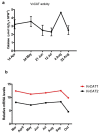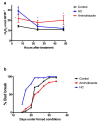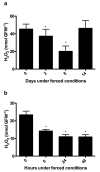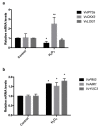Hydrogen Peroxide Increases during Endodormancy and Decreases during Budbreak in Grapevine (Vitis vinifera L.) Buds
- PMID: 34072287
- PMCID: PMC8228137
- DOI: 10.3390/antiox10060873
Hydrogen Peroxide Increases during Endodormancy and Decreases during Budbreak in Grapevine (Vitis vinifera L.) Buds
Abstract
Changes in the level of hydrogen peroxide (H2O2) is a good indicator to monitor fluctuations in cellular metabolism and in the stress responses. In this study, the changes in H2O2 content during bud endodormancy (ED) and budbreak were analysed in grapevine (Vitis vinifera L.). The results showed a gradual increase in the H2O2 content during the development of bud ED, which was mainly due to an increase in the activity of peroxidases (PODs). The maximum H2O2 content reached in the grapevine buds coincided with the maximum depth of bud ED. In contrast, during budbreak, the H2O2 content decreased. As the plant hormones cytokinin (CK) and auxin play an important role in budbreak and growth resumption in grapevine, the effect of exogenous applications of H2O2 on the expression of genes involved in CK and auxin metabolism was analysed. The results showed that H2O2 represses the expression of the CK biosynthesis genes VvIPT3a and VvLOG1 and induces the expression of the CK-inactivating gene VvCKX3, thus reducing potentially the CK content in the grapevine bud. On the other hand, H2O2 induced the expression of the auxin biosynthesis genes VvAMI1 and VvYUC3 and of the auxin transporter gene VvPIN3, thus increasing potentially the auxin content and auxin transport in grapevine buds. In general, the results suggest that H2O2 in grapevine buds is associated with the depth of ED and negatively regulates its budbreak.
Keywords: auxin; budbreak; cytokinin; dormancy; grapevine buds; hydrogen peroxide; peroxidases.
Conflict of interest statement
The authors declare no conflict of interest.
Figures







Similar articles
-
ABA promotes starch synthesis and storage metabolism in dormant grapevine buds.J Plant Physiol. 2019 Mar-Apr;234-235:1-8. doi: 10.1016/j.jplph.2019.01.004. Epub 2019 Jan 4. J Plant Physiol. 2019. PMID: 30639992
-
Cell cycle genes are activated earlier than respiratory genes during release of grapevine buds from endodormancy.Plant Signal Behav. 2017 Oct 3;12(10):e1321189. doi: 10.1080/15592324.2017.1321189. Epub 2017 May 12. Plant Signal Behav. 2017. PMID: 28498020 Free PMC article.
-
Sprouting of paradormant and endodormant grapevine buds under conditions of forced growth: similarities and differences.Planta. 2018 Oct;248(4):837-847. doi: 10.1007/s00425-018-2941-7. Epub 2018 Jun 23. Planta. 2018. PMID: 29936547
-
Hydrogen cyanamide breaks grapevine bud dormancy in the summer through transient activation of gene expression and accumulation of reactive oxygen and nitrogen species.BMC Plant Biol. 2016 Sep 15;16(1):202. doi: 10.1186/s12870-016-0889-y. BMC Plant Biol. 2016. PMID: 27627883 Free PMC article.
-
Cold Hardiness Dynamics and Spring Phenology: Climate-Driven Changes and New Molecular Insights Into Grapevine Adaptive Potential.Front Plant Sci. 2021 Apr 29;12:644528. doi: 10.3389/fpls.2021.644528. eCollection 2021. Front Plant Sci. 2021. PMID: 33995442 Free PMC article. Review.
Cited by
-
Modeling budbreak precocity in grapevine: insights from comparative gene expression analysis in single-node cuttings.Planta. 2025 Apr 5;261(5):104. doi: 10.1007/s00425-025-04677-2. Planta. 2025. PMID: 40186786 Free PMC article.
-
Ethephon-Mediated Bloom Delay in Peach Is Associated With Alterations in Reactive Oxygen Species, Antioxidants, and Carbohydrate Metabolism During Dormancy.Front Plant Sci. 2021 Oct 14;12:765357. doi: 10.3389/fpls.2021.765357. eCollection 2021. Front Plant Sci. 2021. PMID: 34721492 Free PMC article.
-
Localization of Hydrogen Peroxide in Dormant Buds of Resistant and Susceptible Chestnut Cultivars: Changes During Gall Developmental Stages Induced by the Asian Chestnut Gall Wasp (Dryocosmus kuriphilus).Plants (Basel). 2025 Jul 8;14(14):2089. doi: 10.3390/plants14142089. Plants (Basel). 2025. PMID: 40733326 Free PMC article.
-
Changes in Reactive Oxygen Species, Antioxidants and Carbohydrate Metabolism in Relation to Dormancy Transition and Bud Break in Apple (Malus × domestica Borkh) Cultivars.Antioxidants (Basel). 2021 Sep 29;10(10):1549. doi: 10.3390/antiox10101549. Antioxidants (Basel). 2021. PMID: 34679683 Free PMC article.
-
Genetic factors acting prior to dormancy in sour cherry influence bloom time the following spring.J Exp Bot. 2024 Jul 23;75(14):4428-4452. doi: 10.1093/jxb/erae157. J Exp Bot. 2024. PMID: 38602443 Free PMC article.
References
-
- Grant T.N.L., Gargrave J., Dami I.E. Morphological physiological, and biochemical changes in Vitis genotype in responses to photoperiod regimes. Am. J. Enol. Vitic. 2013;64:466–475. doi: 10.5344/ajev.2013.13060. - DOI
-
- Cragin J., Serpe M., Keller M., Shellie K. Dormancy and cold hardiness transition in wine grape cultivars Chardonnay and Cabernet Sauvignon. Am. J. Enol. Vitic. 2017;68:195–202. doi: 10.5344/ajev.2016.16078. - DOI
-
- Lang G.A. Dormancy: A new universal terminology. HortScience. 1987;22:817–820.
-
- Or E., Belausov E., Popilevski I., Tal Y.B. Changes in endogenous ABA level in relation to the dormancy cycle in grapevines grown in a hot climate. J. Hortic. Sci. Biotechnol. 2000;75:190–194. doi: 10.1080/14620316.2000.11511221. - DOI
Grants and funding
LinkOut - more resources
Full Text Sources
Research Materials

